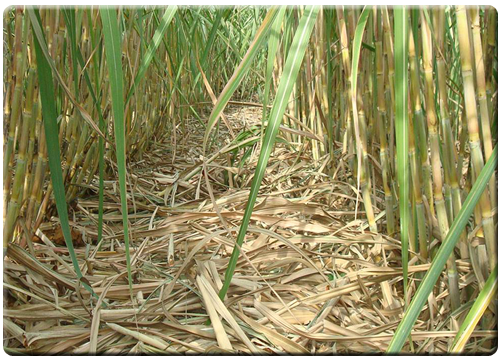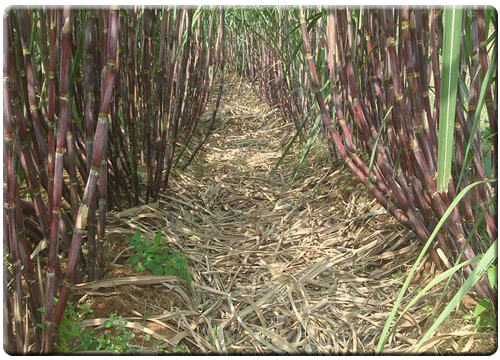TNAU Agritech Portal :: Sustainable Sugarcane Initiative(SSI)
 |
The Sustainable Sugarcane Initiative (SSI) aims at providing practical options to the farmers in improving the productivity of land, water and labour, all at the same time. SSI is also expected to reduce the overall pressure on water resources and contribute to recovery of ecosystems. Sustainable Sugarcane Initiative is an innovative method of sugarcane production using less seeds, less water and optimum utilization of fertilizers and land to achieve more yields. |
|
|
one two three four five |
|



| Sustainable Sugarcane Initiative(SSI) |
The Sustainable Sugarcane Initiative (SSI) aims at providing practical options to the farmers in improving the productivity of land, water and labour, all at the same time. SSI is also expected to reduce the overall pressure on water resources and contribute to recovery of ecosystems. Sustainable Sugarcane Initiative is an innovative method of sugarcane production using less seeds, less water and optimum utilization of fertilizers and land to achieve more yields.
| The major principles that govern SSI |
- Raising nursery in portrays using single budded chips
- Transplanting young seedlings (25-35 days old)
- Maintaining wider spacing (5x2 feet) in the main field
- Providing sufficient moisture through efficient water management technologies viz.,drip fertigation (sub or sub surface)
- Encouraging organic method of nutrient and plant protection measures
- Practicing intercropping with effective utilization of land
|
|
| Overall benefits |
- Improved water use efficiency
- Optimum use of fertilizers favour balanced availability of nutrients
- Better aeration and more penetration of sunlight favours higher sugar content
- Reduced cost of cultivation and increased returns through intercropping
|
Top
|
| Comparison between SSI and Conventional method |
| Particulars |
Conventional |
SSI |
| Seed/Setts/acre |
60,000 single buds(30,000 two budded sett) 4000 kg of cane per acre |
5000 single budded chips(500 kg of cane per acre) |
| Nursery preparation |
No |
Yes |
| Measures to maintain uniformity among plants |
No grading |
Grading is done during nursery |
| Spacing (Row to Row) |
2.0 -3.0 ft. |
5.0 ft. minimum |
| Planting |
Direct planting of setts |
Transplanting of young seedling (25-35 days old) |
| Water requirement |
More water(Flood irrigation) |
Less(Drip fertigation) |
| Mortality rate |
High |
Low |
| No.of tillers/plant |
6 - 8 |
15 - 20 |
| Accessibility to air and sunlight |
Low |
High |
| Scope for intercrop |
NIL |
Possible |
|
Top
|
Selection of single bud Chips
- Select healthy canes of 7 to 9 months old which have good inter node length (7 to 8 inches) and girth
- Observe and avoid canes with disease infestation like fungus growth, spots etc.
Remove buds from the selected canes using an implement called Bud chipper |
|
| Bud Treatment |
| The buds can be treated with 1 Kg urea, 50g Carbendazim and 200 ml malathion dissolved in 100 litres of water and soaked for 15 minutes and shade dried for 15 minutes to induce quick germination of buds. |
|
| The buds can also be treated by biological method by dissolving 2 kg of Tricoderma Viridi in 100 litres of water and soaked for 15 minutes and shade dried for 15 minutes. After chemical / biological treatment, the buds can be treated with 1 per cent lime solution and placed air tight in a gunny bag for 3-4 days. |
| The gunny bags can be opened on the 4th day and healthy sprouted buds can be selected for raising nursery. Bud treatment helps in protecting the crop from pest and disease incidence in later growth stages. |
Top
|
| Nursery |
An optimum environment with good water facility, pro-tray, decomposed coco-pith and polythene sheet are the basic requirements for good nursery in shade net shed is a good proposition to provide shade and create other favourable conditions like warm and wind free environment. |
| Fill half of each cone in the tray with coco-pith and place the buds flat or in a slightly slanting position in the cones. Do not press or push it hard and ensure that the bud side faces up. Cover the bud chips in trays completely with coco-pith. |
Based on the moisture content of coco-pith, watering to the trays (seedlings) has to be done using rose cans. |
|
Top
|
| Transplanting and cultural operations |
|
- Transplant young seedlings of 25-35 days old in the main field
|
- Watering can be stopped one day before transplanting. This will loosen the coco-pith in the cones and help in easy lifting of seedlings for transplanting.
|
- Maintain optimum plant spacing of 5x2 ft. for easy sunlight penetration, profuse tillering and mechanical harvesting.
|
- To moisten the soil, irrigate the field one or two days before transplanting. Similarly, irrigation should be given immediately after planting.
|
- After the establishment of 2 or 3 tillers, the mother shoot may be removed just one inch above the ground to facilitate more number of tillers and uniform maturity.
|
- Wider spacing under SSI provides scope for intercropping with vegetables, pulses, water melon, cucumber and green manure crops. Intercropping facilitates weed control, soil enrichment and additional income.
|
- Weeding has to be done at 30, 60 and 90 days after transplanting. Earthing up has to be done on 45th and 90th day after planting for enhancing aeration and root growth.
|
- For effective photosynthesis, only the top 8-10 leaves are sufficient. Therefore it is important to remove the lower dry and green leaves during 5th and 7th month, and applied as much in the interspaces.
|
Removal of lower dry and green leaves during 5th month |
Removal of lower dry and green leaves during 7th month |
 |
 |
|
Top
|
| Drip Irrigation and fertigation |
The productivity of cane under SSI can be enhanced by practicing drip irrigation with fertigation. Based on the soil type, drip irrigation can be scheduled daily or once in three days. Fertigation can be done at ten days interval. The water use efficiency is higher in drip irrigation and can save irrigation water to the tune of 55 per cent (1200 mm). |
Nutrient management in sugarcane cultivation is very essential for better crop growth. It is always better to know the required quantity of nutrients through soil testing and enrich the soil accordingly. If it is not feasible, NPK can be applied at the rate of 275 kg, 63 kg and 115 kg per hectare, respectively through inorganic or organic sources. |
 |
 |
 |
 |
| Surface Drip |
Subsurface Drip
|
|
| Fertigation schedule for Sugarcane (kg/ha) |
| Crop stage(days after planting) |
Nitrogen |
Phosphorus |
Potassium |
| 0-30 |
39.40 |
0.00 |
0.00 |
| 31-60 |
50.60 |
26.25 |
9.00 |
| 61 -90 |
56.50 |
20.50 |
14.50 |
| 91-120 |
60.20 |
16.25 |
16.00 |
| 121-180 |
57.80 |
0.00 |
40.50 |
| 181 -120 |
10.50 |
0.00 |
35.00 |
| Total |
275 |
63 |
115 |
Top
|
| Comparison of cost of cultivation for sugarcane under surface irrigation, subsurface drip fertigation and SSI under SSDF system |
| Particulars |
Conventional method |
Sub surface drip fertigation (SSDF) |
SSI under SSDF |
| 1.Drip system cost |
- |
12,000 |
12,000 |
| 2. Preparatory cultivation |
8,800 |
10,950 |
10,950 |
| 3. Setts and planting |
23,640 |
16,160 |
15,500 |
| 4.Crop maintenance |
8,400 |
8,400 |
8,400 |
| 5. Fertilizers cost |
5,250 |
5,250 |
5,250 |
| 6. Irrigation/ Drip fertigation |
4,200 |
3,000 |
3,000 |
| 7.Weeding |
3,000 |
3,000 |
3,000 |
| 8. Plant protection |
2,470 |
5,060 |
5,060 |
| 9. Herbigation |
- |
1,257 |
1,257 |
| 10. Chlorine treatment |
- |
600 |
600 |
| 11.Acid treatment |
- |
800 |
800 |
| 12.Micro nutrients |
900 |
900 |
9 00 |
| 13.Harvesting |
42,000(manual) |
48,750(mechanical) |
48,750(mechanical) |
| 14.Yield/ha |
98 t |
175 t |
195 t |
| 15. economics |
| Gross income @ rs.1950/t |
1,91, 100/- |
3,41, 250/- |
3,80,250/- |
| Cost of cultivation |
98,660 |
1,16, 127 |
1,15,467 |
| Net income |
92,440 |
2,25, 123 |
2,64,783 |
| B:C ratio |
1.93 |
2.93 |
3.29 |
|
Top
|
Source The Director,
Water Technology Centre,
TNAU, Coimbatore-641 003.
Phone: 0422-6611278, 0422-6611478
Email: directorwtc@tnau.ac.in |
|
|
 |

